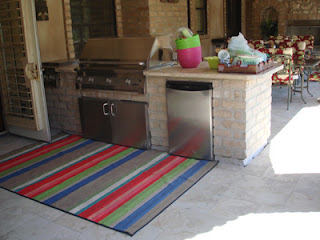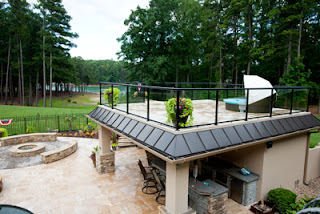Last week we talked about the popularity of outdoor kitchens, but whether you have an expansive outdoor kitchen or a very basic, simple barbecue grill, we’ve got some great tips to help you host the best barbecues ever during your national holiday, the rest of your summer…and with the right decking set-up, all year long!
Meaningful Marinade Facts
- Marinate your meat in advance. Marinades don’t just flavour the meat, it also tenderises.
- While some experts recommend an overnight marinade, most cuts of meat only need 20 minutes to 2 hours in the refrigerator.
- Build your marinade with a combination of acid, oil and flavouring like a good salad dressing. A good guideline is a 1:3 ratio of acidity to oil.
- The acidity tenderizes the food and contributes to tanginess while the oil provides moisture and richness.
- Chose light olive oil or vegetable oil over extra-virgin olive oil (while that might be good for salads and sauces extra-virgin olive oil burns and smokes on contact).
- Marinating more than 2 hours can over-soften some meats or give a tough texture from the acid from citrus or vinegar (never use lemon or lime in a marinade more than 2 hours).
- Smaller, more delicate foods require a shorter soak.
- Avoid using pineapple juice as it is destructive, breaking down meat and fish fibres.
- Marinating meat does more than just tenderise and infuse the meat with flavor; it also inhibits the formation of potentially carcinogenic HCAs (heterocyclic amines) which form when grilling “muscle meats” like poultry, red meat and fish. According to the American Institute for Cancer Research (AICR), marinating can reduce HCA formation by as much as 92-99%.
- Marinate in strong plastic bags or use non-reactive containers like stainless steel or glass.
Preparedness is the Key to Successful Barbecue
- Think ahead. Before you start grilling, make sure you have all you need all the way through to the dining table. Have all of your accompanying side dishes prepared in advance. Make sure you have plenty of gas or charcoal on hand before starting and be sure to start with a clean grill, your barbecue seasonings on hand, cooking tools and utensils, clean plates for removing the food from the grill and your serving plates all ready to go.
- Remove your marinating meat from the refrigerator at least 15-20 minutes before grilling to bring to room temperature before placing on the grill. This helps to ensure you reach the right internal temperature and cook throughout without burning the surface to a crisp.
- Pre-heat your grill15-25 minutes before you want to start cooking. A good pre-heat will help to kill any bacteria on the grilling racks. Use a wire brush to brush off any charred debris when the grill is hot (and scrape it again immediately after use).
- A good pre-heated grill sears the food on contact, but keeps the insides moist and helps prevent sticking.
- To start a charcoal grill, use of a Chimney Starter makes it a breeze. Simply crumple up a little paper, but it on the bottom, fill with charcoal and light the papers. In about 15-20 minutes you have coals ready to spread in the bottom of the grill with no need to use kindling or fluid which can cause unpleasant taste in your food.
- To gauge grill temperature without a thermometer, place your open palm about 5 inches above the grill rack. If you have to move your hand in 2 seconds, the temperature is high. If you move your hand in 5 seconds, your temperature is medium and if you move your hand at 10 seconds, the temperature is low.
- Oil your grill to further prevent sticking. Even on a clean grill, lean foods can stick when directly on a rack. By using a folded paper towel soaked in vegetable oil and held with a tong, you can rub it over the entire rack. Be sure NOT to use spray oil on a hot grill.
- Food Safety Tip: avoid cross contamination by using separate cutting boards for raw and cooked foods, refrigerate foods while marinating, and NEVER baste with the marinating liquid (Make extra marinade just for basting).
- Don’t cook cold meat. Bring it up to room temperature to help get the internal temperature on the grill without burning the surface. Using thinner steaks makes it easier to get the inside temperature right.
Grilling it Right
- Be sure to use lean cuts of meat or trim excess fat and remove poultry skin. This will reduce flare-ups which happen when fat drips onto the heat source and catches fire which reportedly causes carcinogenic PAHs (polycyclic aromatic hydrocarbons) and can accumulate on the food being grilled.
- If flare ups do occur, some experts recommend keeping a squirt bottle on hand to squelch unexpected flare-ups, but others say avoid the use of water bottles as they can just spread the burning oil…instead just close the grill lid and cutting of the oxygen will not allow the flames to survive.
- Before placing on the grill, be sure to pat the meat dry from the marinade to properly sear (still wet with marinade will steam the meat and you can lose that caramelized texture you are going for with the grill.
- Foods that are small and finicky might fall through the grill rack or may be too cumbersome to turn over one-by-one ideally make use of a grill basket.
- If you are using bamboo skewers, be sure to soak them in water before use.
- Avoid over-turning your meat. To get the ideal, caramelized barbecue crust on your meat, only turn it once or twice.
- Don’t squish down the meat and force the juices out. That just leaves you with an overly dry protein.
- Don’t be afraid to expand your barbecue horizons…play with pre and post cooking marinades, dry rubs, skewers, cooking in parcels, slow cooking and smoking.
- To add the ‘smoke’ flavour to your meat, wood chips can be placed directly on charcoal grill coals, or make a simple foil basket filled with wood chips to place on grates directly over the heat on a gas grill.
- When roasting, place the meat over indirect heat (or flame-free area). If you need to create an in-direct cooking area, just turn one burner off on a gas grill or simply push coals to one side on a charcoal grill. Keep the lid of the grill closed and avoid opening repeatedly as it can take 10 minutes for the temperature to climb back up after opening the lid.
- When cooking chicken, boneless cuts cook well over direct heat, but bone-in pieces require a longer cook time and should be placed over indirect head to avoid burning outside and getting a cook all the way through.
- At the end of cooking time, season or add a glaze for extra flavor. Melted jam is the quickest and easiest glaze and should be brushed on at the end of cooking or immediately when removed from grill.
- After cooking, let the meat rest on a clean platter for about 10 minutes. While some experts recommend covering with tented foil, others claim this can make your meat soggy with the steam so we recommend tenting your foil to keep the heat in while your meat in settling, letting the juices permeate back through the meat fibres, but cut a small venting hole in the foil to allow any steam to escape.
But My Deck Leaves Much to be Desired…. What do I do?
If you want to show off your barbecue expertise but are not thrilled at the idea of hosting a barbecue on an unattractive, neglected deck, how can you transform your high maintenance, unsightly deck into one you’d be proud of and could allow you to enjoy grilling throughout the year?...- Contact one of our skilled Duradek professionals to help transform your old deck into a gorgeous, low maintenance place of leisure. Act fast to reach a busy Duradek installer and you can potentially have a deck transformation before the Labor Day weekend!
Enjoy your Holidays!











